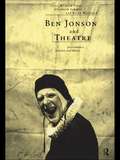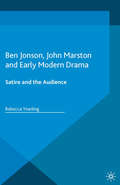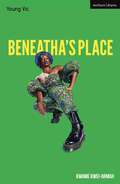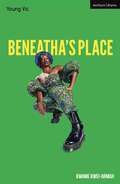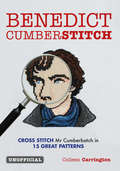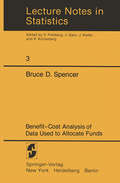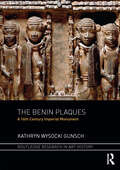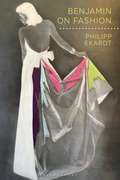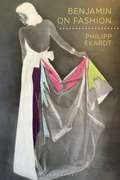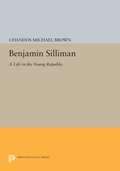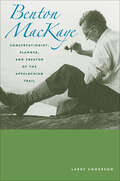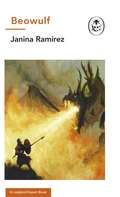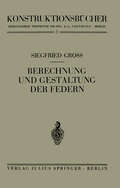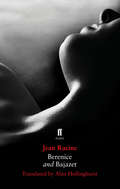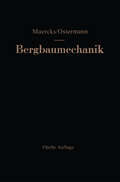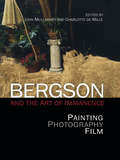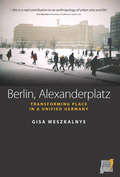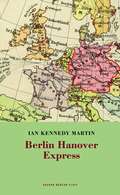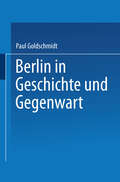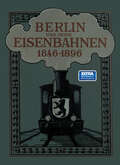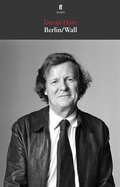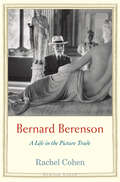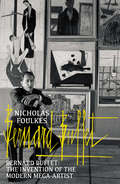- Table View
- List View
Ben Jonson and Theatre: Performance, Practice and Theory
by Richard Cave Elizabeth Schafer Brian WoollandBen Jonson and Theatre is an investigation and celebration of Jonson's plays from the point of view of the theatre practitioner as well as the teacher. Reflecting the increasing interest in the wider field of Renaissance drama, this book bridges the theory/practice divide by debating how Jonson's drama operates in performance. Ben Jonson and Theatre includes: * discussions with and between practitioners * essays on the staging of the plays * edited transcripts of interviews with contemporary practitioners The volume includes contributions from Joan Littlewood, Sam Mendes, John Nettles, Simon Russell Beale and Geoffrey Rush, Oscar-winning actor for Shine.
Ben Jonson, John Marston and Early Modern Drama: Satire and the Audience
by Rebecca YearlingThis book examines the influence of John Marston, typically seen as a minor figure among early modern dramatists, on his colleague Ben Jonson. While Marston is usually famed more for his very public rivalry with Jonson than for the quality of his plays, this book argues that such a view of Marston seriously underestimates his importance to the theatre of his time. In it, the author contends that Marston's plays represent an experiment in a new kind of satiric drama, with origins in the humanist tradition of serio ludere. His works—deliberately unpredictable, inconsistent and metatheatrical—subvert theatrical conventions and provide confusingly multiple perspectives on the action, forcing their spectators to engage actively with the drama and the moral dilemmas that it presents. The book argues that Marston's work thus anticipates and perhaps influenced the mid-period work of Ben Jonson, in plays such as Sejanus, Volpone and The Alchemist.
Beneatha's Place (Modern Plays)
by Kwame Kwei-ArmahSome things we do for those we are responsible for, some things for ourselves, and some things we do for the ancestors.Today, it's all three!1959. The first wave of independence is sweeping across Africa and Beneatha has left the prejudice of 1950s America for a brighter future with her Nigerian husband in Lagos. But on the day they move into their new house in the white suburbs, it doesn't take long for cracks to appear, changing the course of the rest of their lives.Present day. Now a renowned Dean whose colleagues are questioning the role of African American studies for future generations, Beneatha returns to the same house in search of answers. Inspired by Lorraine Hansberry's ground-breaking modern classic, A Raisin in the Sun, Beneatha's Place challenges today's culture wars about colonial history and reckoning with the past. A razor-sharp satire from Young Vic Artistic Director Kwame Kwei-Armah, about the power of knowing your history and the cost of letting it go, this edition was published to coincide with the London premiere at the Young Vic Theatre, in June 2023.
Beneatha's Place (Modern Plays)
by Kwame Kwei-ArmahSome things we do for those we are responsible for, some things for ourselves, and some things we do for the ancestors.Today, it's all three!1959. The first wave of independence is sweeping across Africa and Beneatha has left the prejudice of 1950s America for a brighter future with her Nigerian husband in Lagos. But on the day they move into their new house in the white suburbs, it doesn't take long for cracks to appear, changing the course of the rest of their lives.Present day. Now a renowned Dean whose colleagues are questioning the role of African American studies for future generations, Beneatha returns to the same house in search of answers. Inspired by Lorraine Hansberry's ground-breaking modern classic, A Raisin in the Sun, Beneatha's Place challenges today's culture wars about colonial history and reckoning with the past. A razor-sharp satire from Young Vic Artistic Director Kwame Kwei-Armah, about the power of knowing your history and the cost of letting it go, this edition was published to coincide with the London premiere at the Young Vic Theatre, in June 2023.
Benedict Cumberstitch: Crossstitch Mr Cumberbatch in 15 great patterns
by Angela WrightYou've watched all his films, you've coloured him in, and, let's face it, you've tried out how your signature would look with 'Cumberbatch' at the end of it - now it's time to get stitching! Benedict Cumberstitch is your unofficial guide to creating a series of amazing cross stitch designs featuring the Cumberbatch in all his glory. Beginners can quickly pick up the simple yet addictive art of cross stitch, and seasoned stitchers will be delighted by the range of designs on offer. Whether you want to see him smouldering in a tuxedo, delivering a soliloquy as Hamlet, or photobombing with the best of them, there's sure to be patterns here to satisfy even the most dedicated of Cumberbitches.
Benefit-Cost Analysis of Data Used to Allocate Funds (Lecture Notes in Statistics #3)
by Bruce SpencerThis monograph treats the question of determining how much to spend for the collection and analysis of public data. This difficult problem for government statisticians and policy-makers is likely to become even more pressing in the near future. The approach taken here is to estimate and compare the benefits and costs of alternative data programs. Since data are used in many ways, the benefits are hard to measure. The strategy I have adopted focuses on use of data to determine fund allocations, particularly in the General Revenue Sharing program. General Revenue Sharing is one of the largest allocation programs in the United States. That errors in population counts and other data cause sizable errors in allocation has been much publicized. Here we analyze whether the accuracy of the 1970 census of population and other data used by General Revenue Sharing should be improved. Of course it is too late to change the 1970 census program, but the method and techniques of analysis will apply to future data programs. In partic ular, benefit-cost analyses such as this are necessary for informed decisions about whether the expense of statistical programs is justi fied or not. For example, although a law authorizing a mid-decade census was enacted in 1976, there exists great doubt whether funds will be provided so a census can take place in 1985. (The President's Budget for 1981 allows no money for the mid-decade census, despite the Census Bureau's request for $1. 9 million for planning purposes.
The Benin Plaques: A 16th Century Imperial Monument (Routledge Research in Art History)
by Kathryn Wysocki GunschThe 16th century bronze plaques from the kingdom of Benin are among the most recognized masterpieces of African art, and yet many details of their commission and installation in the palace in Benin City, Nigeria, are little understood. The Benin Plaques, A 16th Century Imperial Monument is a detailed analysis of a corpus of nearly 850 bronze plaques that were installed in the court of the Benin kingdom at the moment of its greatest political power and geographic reach. By examining European accounts, Benin oral histories, and the physical evidence of the extant plaques, Gunsch is the first to propose an installation pattern for the series.
The Benin Plaques: A 16th Century Imperial Monument (Routledge Research in Art History)
by Kathryn Wysocki GunschThe 16th century bronze plaques from the kingdom of Benin are among the most recognized masterpieces of African art, and yet many details of their commission and installation in the palace in Benin City, Nigeria, are little understood. The Benin Plaques, A 16th Century Imperial Monument is a detailed analysis of a corpus of nearly 850 bronze plaques that were installed in the court of the Benin kingdom at the moment of its greatest political power and geographic reach. By examining European accounts, Benin oral histories, and the physical evidence of the extant plaques, Gunsch is the first to propose an installation pattern for the series.
Benjamin on Fashion (Walter Benjamin Studies)
by Philipp EkardtBenjamin on Fashion reconstructs and redefines Walter Benjamin's complex, fragmentary and yet influential fashion theory that he developed in the Arcades Project (1927-1940) and beyond, while situating it within the environment from which it emerged - 1930s Parisian couture. In this insightful new book, Philipp Ekardt brings Benjamin intodiscussion with a number of important, but frequently overlooked sources. Amongst many others, these include the German fashion critic Helen Grund, who introduced him to the contemporary fashion scene; Georg Simmel's fashion sociology; Henri Focillon's morphological art history; designs by Elsa Schiaparelli and Madeleine Vionnet; films by L'Herbier and others starring Mae West; and the photography of George Hoyningen-Huene and Man Ray.In doing so, Ekardt demonstrates how fashion and silhouettes became grounded in sex; how an ideal of the elegant animation of matter was pitted against the concept of an obdurate fashion form; and how Benjamin's idea of 'fashion's tiger's leap into the past' paralleled the return of 1930s couture to the depths of (fashion) history. The use of such relevant sources makes this crucial for understanding Benjamin both as a thinker and a cultural theorist.
Benjamin on Fashion (Walter Benjamin Studies)
by Philipp EkardtReconstructing Benjamin's complex, fragmentary, yet influential ideas about fashion, this book defines Benjamin's fashion theory, beginning with Convolute B: Fashion in the German thinker's Arcades Project (1927-1940), tracing it through Theses on the Concept of History and beyond.Bringing Benjamin's work into discussion with a number of important but frequently overlooked sources, Philipp Ekardt shows the relevance of Georg Simmel's fashion sociology, art historian Henri Focillon's morphological theories of form, and the writings of German fashion critic Helen Grund, who introduced Benjamin to the fashion scene of his time. Systematically investigating fashion as the 'temporalized processing of difference', as emerging from a reading of Simmel's fashion sociology, Ekardt shows how this idea is modified in Benjamin's fashion-informed philosophies of history and the image, as well as considering how Benjamin's concept of materiality can be related to clothing, and in contrast to an aesthetic of elegance. He tackles the grounding of fashion in sex through morphological motifs in Benjamin's fashion theory, examining the shifts from the androgynous looks of 1920s, to the overtly gender-signposted silhouettes of the 1930s. Pointing to surprising parallels in the overall historical thrust of the Arcades Project – to work through the 19th century – and the fashionable resurgence of Belle Époque styles while Benjamin was at work on his project, Ekardt also makes a case for understanding fashion as key to appreciating the historical significance and prescience of Benjamin's unfinished magnum opus.Situating Benjamin's thought within the fashion panorama of his moment, this is a crucial text for understanding Benjamin both as a thinker and cultural theorist.
Benjamin Silliman: A Life in the Young Republic (PDF)
by Chandos Michael BrownPoet, essayist, chemist, geologist, educator, entrepreneur, publisher--Benjamin Silliman (1779-1864) was one of the virtuosi of the Early Republic and a founder of the American scientific community. This absorbing biography is not only a study of the youth and early career of a complex and remarkable man but also a window on his times. In lively and often moving detail, Chandos Michael Brown opens the broad context of Silliman's life in his native Connecticut. From Silliman's father's disastrous captivity among the British during the Revolution to the intensities of New England religious revivals, from the international celebrity of the Weston Meteor to the economic hazards of introducing artificial mineral waters to the New York market, here is an engaging portrayal of the growth of an American scientist within his rich cultural setting. Brown tells how the young Silliman confronted the declining fortunes of his distinguished family and how he strove to invent a new career worthy of his ambition and social standing. He describes Silliman's education at Yale College and in Philadelphia, his European tour, and his subsequent activities as a professor of chemistry and mineralogy, founder of the Yale Medical School, and editor of the American Journal of Science. Throughout this cultural biography, Silliman appears as the concerned member of an often troubled family--a man who nonetheless managed to achieve that elusive quality, greatly admired by his contemporaries, that of the representative American.Originally published in 1990.The Princeton Legacy Library uses the latest print-on-demand technology to again make available previously out-of-print books from the distinguished backlist of Princeton University Press. These editions preserve the original texts of these important books while presenting them in durable paperback and hardcover editions. The goal of the Princeton Legacy Library is to vastly increase access to the rich scholarly heritage found in the thousands of books published by Princeton University Press since its founding in 1905.
Benton MacKaye: Conservationist, Planner, and Creator of the Appalachian Trail (Creating the North American Landscape)
by Larry AndersonPlanner and originator of the Appalachian Trail and a cofounder of the Wilderness Society, Benton MacKaye (1879-1975) was a pioneer in linking the concepts of preservation and recreation. Spanning three-quarters of a century, his long and productive career had a major impact on emerging movements in conservation, environmentalism, and regional planning. MacKaye's seminal ideas on outdoor recreation, wilderness protection, land-use planning, community development, and transportation have inspired generations of activists, professionals, and adventurers seeking to strike a harmonious balance between human need and the natural environment.This pathbreaking biography provides the first complete portrait of this significant and unique figure in American environmental, intellectual, and cultural history. Drawing on extensive research, Larry Anderson traces MacKaye's extensive career, examines his many published works, and describes the importance of MacKaye's relationships with such influential figures as Lewis Mumford, Aldo Leopold, and Walter Lippmann. This book will appeal to students, scholars, and professionals in preservation, conservation, recreation, planning, and American studies, as well as general readers interested in these subjects.
Benton MacKaye: Conservationist, Planner, and Creator of the Appalachian Trail (Creating the North American Landscape)
by Larry AndersonPlanner and originator of the Appalachian Trail and a cofounder of the Wilderness Society, Benton MacKaye (1879-1975) was a pioneer in linking the concepts of preservation and recreation. Spanning three-quarters of a century, his long and productive career had a major impact on emerging movements in conservation, environmentalism, and regional planning. MacKaye's seminal ideas on outdoor recreation, wilderness protection, land-use planning, community development, and transportation have inspired generations of activists, professionals, and adventurers seeking to strike a harmonious balance between human need and the natural environment.This pathbreaking biography provides the first complete portrait of this significant and unique figure in American environmental, intellectual, and cultural history. Drawing on extensive research, Larry Anderson traces MacKaye's extensive career, examines his many published works, and describes the importance of MacKaye's relationships with such influential figures as Lewis Mumford, Aldo Leopold, and Walter Lippmann. This book will appeal to students, scholars, and professionals in preservation, conservation, recreation, planning, and American studies, as well as general readers interested in these subjects.
Beowulf: A Ladybird Expert Book (The Ladybird Expert Series)
by Janina RamirezPart of the ALL-NEW LADYBIRD EXPERT SERIES- Which is more terrifying - a monster or its mother? - Why did Berserkers run naked into battle? - How was the story of Beowulf almost lost forever?PLUNGE into the adventures of Beowulf, the 6th Century hero who defeated the monster Grendel, became king of his people, and slayed a tremendous dragon. Surviving in a single, burnt manuscript, Beowulf continues to entrance readers and inspire major works of fantasy today.WARRIORS. MONSTERS. DRAGONS. GOLD.Janina Ramirez's Beowulf is an accessible and authoritative guide to the spellbinding world and daring feats of a poem remembered through the centuries.
Berechnung und Gestaltung der Federn (Konstruktionsbücher #3)
by Siegfried GroßDieser Buchtitel ist Teil des Digitalisierungsprojekts Springer Book Archives mit Publikationen, die seit den Anfängen des Verlags von 1842 erschienen sind. Der Verlag stellt mit diesem Archiv Quellen für die historische wie auch die disziplingeschichtliche Forschung zur Verfügung, die jeweils im historischen Kontext betrachtet werden müssen. Dieser Titel erschien in der Zeit vor 1945 und wird daher in seiner zeittypischen politisch-ideologischen Ausrichtung vom Verlag nicht beworben.
Berenice and Bajazet
by Alan Hollinghurst Jean RacineThe critical event in Berenice, the death of Titus's father, the Emperor Vespasian, happens a week before the play opens. Thereafter Titus knows that his separation from Berenice is inevitable. The breaking off of a great love affair involves too the hopes of Antiochus, himself long in love with Berenice. The play pushes all three of its principals to the brink, not of revenge but of self-murder, before in her sublime last speech Berenice redeems and directs them all in an act of collective abnegation.Many tears are shed, but not a drop of blood. The effect is unconventional, and profound: the pained acceptance of the irreconcilable in human affairs, and the surrender, by each of the main characters, of the person they most love.Bajazet is Racine's most violent drama; it ends, like Phèdre, with a female character's on-stage suicide, here the culmination of a vividly described sequence of off-stage murders. The setting, in a claustrophobic space within the harem at Constantinople, menaced from both without and within, seems to license a violence of emotion as well as of deed.Violent too are the repeated reversals of fortune, and the terrifying acceleration of the play towards its inexorable catastrophe.Alan Hollinghurst's translation of Berenice premiered at the Donmar Warehouse, London, in October 2012 and Bajazet, at the Almeida Theatre, London, in November 1990.
Bergbaumechanik: Lehrbuch für bergmännische Lehranstalten Handbuch für den praktischen Bergbau
by Josef Maercks Walter OstermannBergson and the Art of Immanence: Painting, Photography, Film, Performance
by John Ó Maoilearca Charlotte De MilleThis collection of 16 essays brings 20th-century French philosopher Henri Bergson's work on immanence together with the latest ideas in art theory and the practice of immanent art as found in painting, photography, film and performance.
Berlin, Alexanderplatz: Transforming Place in a Unified Germany (Space and Place #1)
by Gisa WeszkalnysA benchmark study in the changing field of urban anthropology, Berlin, Alexanderplatz is an ethnographic examination of the rapid transformation of the unified Berlin. Through a captivating account of the controversy around this symbolic public square in East Berlin, the book raises acute questions about expertise, citizenship, government and belonging. Based on ethnographic fieldwork in the city administration bureaus, developers’ offices, citizen groups and in Alexanderplatz itself, the author advances a richly innovative analysis of the multiplicity of place. She reveals how Alexanderplatz is assembled through the encounters between planners, citizen activists, social workers, artists and ordinary Berliners, in processes of popular participation and personal narratives, in plans, timetables, documents and files, and in the distribution of pipes, tram tracks and street lights. Alexanderplatz emerges as a socialist spatial exemplar, a ‘future’ under construction, an object of grievance, and a vision of robust public space. This book is both a critical contribution to the anthropology of contemporary modernity and a radical intervention in current cross-disciplinary debates on the city.
Berlin Hanover Express (Oberon Modern Plays)
by Ian Kennedy MartinBerlin, in the Autumn of 1942.Inside the Irish consulate, officials and diplomats try to carry on their routine business. Outside, RAF bombing of the capital of the Third Reich intensifies. As the security services start to uncover the true origins of the consulate’s German cook, should the staff step into protect her or will their neutrality render them powerless in preventing the crimes unfolding around them?As the secrets of the Nazi regime are uncovered, can a country remain neutral in a time of war?Berlin Hanover Express premiered at the Hampstead Theatre, London in March 2009
Berlin in Geschichte und Gegenwart
by Paul GoldschmidtDieser Buchtitel ist Teil des Digitalisierungsprojekts Springer Book Archives mit Publikationen, die seit den Anfängen des Verlags von 1842 erschienen sind. Der Verlag stellt mit diesem Archiv Quellen für die historische wie auch die disziplingeschichtliche Forschung zur Verfügung, die jeweils im historischen Kontext betrachtet werden müssen. Dieser Titel erschien in der Zeit vor 1945 und wird daher in seiner zeittypischen politisch-ideologischen Ausrichtung vom Verlag nicht beworben.
Berlin und seine Eisenbahnen 1846–1896: Erster Band
by Königlich Preussischen Ministers der Öffentlichen ArbeitenBerlin/Wall
by David HareBerlin/WallIn two contrasted readings for the stage, David Hare visits a place where a famous wall has come down; then another where a wall is going up.BerlinFor his whole adult life, David Hare has been visiting the city which so many young people regard as the most exciting in Europe. But there's something in Berlin's elusive character that makes him feel he's always missing the point. Now, to celebrate the twentieth anniversary of the reunification, he offers a meditation about Germany's restored capital - both what it represents in European history, and the peculiar part it has played in his own life.WallThe Israeli/Palestine security fence will one day stretch 486 miles, from one end of Israel to the other. It will be four times as long as the Berlin wall, and in places twice as high. In this second monologue, the playwright recalls his trips to both Israel and the Palestinian territory and offers a history of the wall's building, an exploration of the philosophy behind it and a personal account of those who live on either side. Berlin premiered at the National Theatre, London, in February 2009 and Wall premiered at the Royal Court Theatre, London, in March 2009.'Of all British dramatists, Hare is the one who has always seemed to have the sharpest awareness of what is going on around him, which is what makes him such an eagerly sought-after journalist.' Michael Billington
Bernard Berenson: A Life in the Picture Trade (Jewish Lives)
by Rachel CohenWhen Gilded Age millionaires wanted to buy Italian Renaissance paintings, the expert whose opinion they sought was Bernard Berenson, with his vast erudition, incredible eye, and uncanny skill at attributing paintings. They visited Berenson at his beautiful Villa I Tatti, in the hills outside Florence, and walked with him through the immense private library-which he would eventually bequeath to Harvard-without ever suspecting that he had grown up in a poor Lithuanian Jewish immigrant family that had struggled to survive in Boston on the wages of the father’s work as a tin peddler. Berenson’s extraordinary self-transformation, financed by the explosion of the Gilded Age art market and his secret partnership with the great art dealer Joseph Duveen, came with painful costs: he hid his origins and felt that he had betrayed his gifts as an interpreter of paintings. Nevertheless his way of seeing, presented in his books, codified in his attributions, and institutionalized in the many important American collections he helped to build, goes on shaping the American understanding of art today. This finely drawn portrait of Berenson, the first biography devoted to him in a quarter century, draws on new archival materials that bring out the significance of his secret business dealings and the way his family and companions-including his patron Isabella Stewart Gardner, his lover Belle da Costa Greene, and his dear friend Edith Wharton-helped to form his ideas and his legacy. Rachel Cohen explores Berenson’s inner world and exceptional visual capacity while also illuminating the historical forces-new capital, the developing art market, persistent anti-Semitism, and the two world wars-that profoundly affected his life.
Bernard Buffet: The Invention of the Modern Mega-artist
by Nicholas FoulkesIt is said that asphyxiation brings on a state of hallucinatory intoxication...in which case the 71 year old artist who lay in his sprawling Provencal villa died happy. In the early afternoon of Monday 4 October 1999, wracked with Parkinson's, and unable to paint because of a fall in which he had broken his wrist, Bernard Buffet calmly placed a plastic bag over his head, taped it tight around his neck and patiently waited the few minutes it took for death to arrive. Bernard Buffet:The Invention of the Modern Mega-artist tells the remarkable story of a French figurative painter who tasted unprecedented critical and commercial success at an age when his contemporaries were still at art school. Then, with almost equal suddenness the fruits of fame turned sour and he found himself an outcast. Scarred with the contagion of immense commercial success no leper was more untouchable. He was the first artist of the television age and the jet age and his role in creating the idea of a post-war France is not to be underestimated. As the first of the so-called Fabulous Five (Francoise Sagan, Roger Vadim, Brigitte Bardot and Yves Saint Laurent) he was a leader of the cultural revolution that seemed to forge a new France from the shattered remains of a discredited and demoralized country. Rich in incident Buffet’s remarkable story of bisexual love affairs, betrayal, vendettas lasting half a century, shattered reputations, alcoholism, and drug abuse, is played out against the backdrop of the beau monde of the 1950s and 1960s in locations as diverse as St Tropez, Japan, Paris, Dallas, St Petersburg and New York, before coming to its miserable conclusion alone in his studio.
